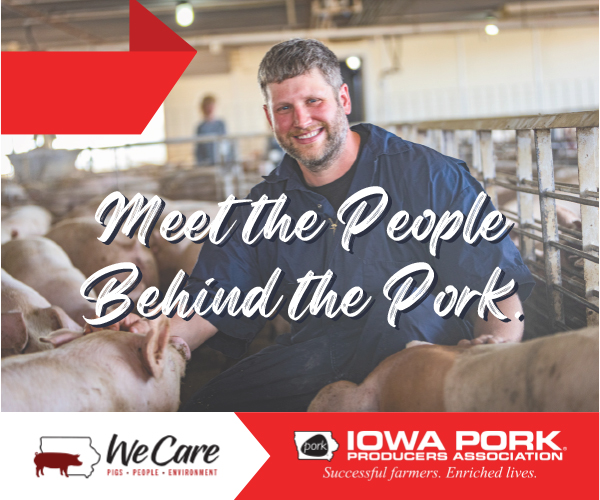Mari Hunt Wassink (left), Dan Hogan (center) and Jake Kundert work in Grow: Johnson County’s five-acre farm in Iowa City. Produce from these fields go to those in need around the area.
Writer: Veronica Lorson Fowler
Photographers: Joe Crimmings and Duane Tinkey
Iowa may have the land, soil and climate ideal for growing crops, but there are still people who don’t have enough fresh produce to sustain a healthy diet. Here’s how four organizations around the state are helping.
Grow: Johnson County (Iowa City)
For Grow: Johnson County, it’s not enough to raise 25,000 pounds of fresh produce annually to distribute to hunger-relief agencies in the area. It’s also important that they train growers, people who will be leaders in the food system for decades to come.
“We want to create long-term change,” says Jake Kundert, former food systems director at Iowa Valley Resource Conservation and Development, the parent organization, where he worked through summer 2021 before starting work on a doctorate degree program.
That’s why Grow: Johnson County takes its training programs just as seriously as delivering fresh greens, tomatoes, peppers, onions and watermelon—all grown on their five-acre farm located on the edge of Iowa City—to food pantries and distribution centers. Paid apprenticeships teach agricultural and food distribution basics. The organization also hosts a class, “Beyond Rootimentary,” as an educational outreach program where community members of all ages can learn more about gardening.
The organization works hard to reach out to food-insecure people about their preferences, which are considered when making decisions about what to grow on the farm. Only top-quality vegetables are distributed. They’re harvested at their peak and delivered within five hours of harvest.
There’s also a focus on providing opportunities to underrepresented individuals in Midwestern agriculture, including Black and Indigenous people and other people of color. The group’s mission emphasizes a more sustainable future for the planet as well, growing cover crops to protect soils, nurturing habitats for beneficial insects, and following organic pest and weed management practices.
Kayla Carter, a former summer apprentice, grew up in Chicago and had never gardened before. She weeded, harvested, inspected fields and prepped produce for distribution. A University of Iowa student majoring in global health studies and African-American studies, Carter says the experience has altered the course of her career: “I saw how this wasn’t just a job. It’s building a whole community.”
Story County Plant A Row (Ames)
As anyone who has planted a garden knows, you often end up with far more produce than you can use. Enter Plant a Row for the Hungry. This national program encourages local gardeners to plant a little extra and donate it to local food pantries or other food distribution organizations.
The program can be informal, like one gardener planting a little extra and donating it. Or it can be more organized, as in the case of Story County Plant a Row (PAR).
“Everyone does Plant a Row a little differently with the same goal,” says Linda Naeve, co-coordinator of Story County PAR.
An intern from Reiman Gardens on the Iowa State University campus launched the organization 15 years ago, donating fresh produce grown on-site, which the garden still does today. PAR also works with Ames farmers markets to donate leftovers to those in need.
A big part of PAR’s work is connecting with local gardeners and providing guidance on what to grow. Once a week, Reiman Gardens serves as a collection center for gardeners to bring their produce, which is then distributed throughout Story County. Local gardeners account for about three-fourths of the produce PAR collects.
Because of COVID-19, 2020 was a record year for the organization. PAR donated more than 13,000 pounds of produce, nearly double that of the previous year.
Two of PAR’s star contributors are Jim and Jeanne Roth of Ames. They live on an acreage just inside the city limits, with about an acre devoted to food production—fruit trees, an asparagus patch, and a variety of vegetables. When the pandemic hit and they knew there would be a need, they nearly tripled their produce. They hit a personal record of 7,255 pounds, which included an entire truckload of butternut squash.
Jim Roth says he recognizes that PAR is valuable for the recipients, “but it is also a really important service to gardeners. We enjoy gardening but produce far more than we can use. This helps us make sure it doesn’t go to waste.”
Quad Cities Food Forest (Davenport)
Imagine a world with no hunger, where communities are filled with free food so anyone who is hungry can simply gather or pick what they need. In the Quad Cities, a visionary group is taking important first steps toward that utopian ideal.
Quad Cities Food Forest embraces the concept of “food forests,” a movement started in the United Kingdom in the 1980s. A food forest, also called a forest garden, is a diverse planting of greenery that attempts to mimic ecosystems and patterns found in nature. The emphasis is on permanent plantings, especially natives, such as fruit trees, shrubs and traditional garden produce.
Food forests provide not only food, but also a wildlife habitat, erosion control and watershed management in an ecologically sustainable way. It also creates pleasant green space for the community.
Started in 2014, Quad Cities Food Forest, a nonprofit, is gaining momentum with a loyal corps of volunteers and harvesters. “Last year our fruit trees were really starting to produce,” says Executive Director Ali Domino Keenan. “And they were picked clean by the end of the season.”
The organization works with cities and private landowners to grow freely accessible edible landscapes. It hosts regular public workshops, events and meetings and supervises six food forest sites on public land in the area, including public parks.
Becky Schumacher, a volunteer, says she enjoys changing people’s minds about what good land stewardship can look like. “I see a wide-open piece of land and think about how it could be used to help all the people out there who are hunting for good, healthy food,” she says.
Up From The Earth (Sioux City)
Food-insecure individuals often have difficulty getting produce not just because of cost, but also because of logistics. It’s challenging for food agencies to manage fresh produce, which can spoil in just a few days.
That’s what this Sioux City group hopes to prevent. Founded eight years ago by retired dentist Randy Burnight, it connects home gardeners—many of whom have been urged to plant a little extra to share—with collection points that quickly transport food to pantries.
The organization has a system of 25 collection sites, each run by a produce coordinator. Their job is to ensure food doesn’t go to waste, aiming to get food into the hands of those who need it within a day or two.
“It’s ever-changing and fluid,” Burnight says. “The garden produce coordinator serves as a sort of broker to get produce to the people who need it.”
To date, almost 30 local churches and organizations have helped make fresh produce available in neighborhoods considered food deserts.
Volunteer Mark Raymond is one of the more well-known members of the organization. Known as “the Zucchini Man,” he dresses up in a giant zucchini costume at the local farmers market to spread awareness about Up From the Earth and hunger in the area. He also grows produce for the program.
“It’s important that our community do what we can to address hunger,” Raymond says. “It’s seems so basic: Everyone deserves simple, fresh foods.”









